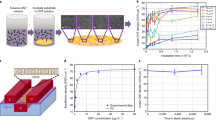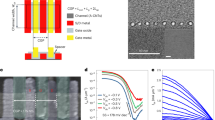Abstract
It is anticipated that the scaling of silicon complementary metal–oxide–semiconductor (CMOS) devices will end around 2020, but alternative technologies capable of maintaining advances in computing power and energy efficiency have not yet been established. Among various options, carbon-nanotube-based electronics has been shown to be one of the most promising candidates. A range of methods have been developed to prepare high-purity semiconducting carbon nanotubes suitable for use in integrated circuits, and 5 nm nanotube transistors with superior performance to that of silicon CMOS have been demonstrated. Here, we explore the potential of carbon nanotube digital electronics. We examine the development of nanotube-based CMOS field-effect transistors and the different nanotube material systems available to build integrated circuits. We also highlight the medium-scale integrated circuits created to date and consider the challenges that exist in delivering large-scale systems.
This is a preview of subscription content, access via your institution
Access options
Access Nature and 54 other Nature Portfolio journals
Get Nature+, our best-value online-access subscription
$29.99 / 30 days
cancel any time
Subscribe to this journal
Receive 12 digital issues and online access to articles
$119.00 per year
only $9.92 per issue
Buy this article
- Purchase on Springer Link
- Instant access to full article PDF
Prices may be subject to local taxes which are calculated during checkout





Similar content being viewed by others
References
Service, R. F. Is silicon’s reign nearing its end. Science 323, 1000–1002 (2009).
Waldrop, M. M. The chips are down for Moore’s law. Nature 530, 144–147 (2016).
Iijima, S. Helical microtubules of graphitic carbon. Nature 354, 56–58 (1991).
Chau, R. et al. Benchmarking nanotechnology for high-performance and low-power logic transistor applications. IEEE Trans. Nanotechnol. 4, 153–158 (2005).
George, S. et al. Toward high-performance digital logic technology with carbon nanotubes. ACS Nano 8, 8730–8745 (2014).
20 years of nanotube transistors. Nat. Electron. 1, 149 (2018).
Tans, S. J., Verschueren, A. R. M. & Dekker, C. Room-temperature transistor based on a single carbon nanotube. Nature 393, 49–52 (1998).
Martel, R., Schmidt, T., Shea, H. R., Hertel, T. & Avourisa, Ph Single- and multi-wall carbon nanotube field-effect transistors. Appl. Phys. Lett. 73, 2447–2449 (1998).
Javey, A., Guo, J., Wang, Q., Lundstrom, M. & Dai, H. J. Ballistic carbon nanotube field-effect transistors. Nature 424, 654–657 (2003).
Bockrath, M. et al. Chemical doping of individual semiconducting carbon-nanotube ropes. Phys. Rev. B 61, R10606–R10608 (2000).
Zhou, C., Kong, J., Yenilmez, E. & Dai, H. J. Modulated chemical doping of individual carbon nanotubes. Science 290, 1552–1555 (2000).
Novoselov, K. S. et al. Electric field effect in atomically thin carbon films. Science 306, 666–669 (2004).
Zhang, Z. Y. et al. Doping-free fabrication of carbon nanotube based ballistic CMOS devices and circuits. Nano Lett. 7, 3603–3607 (2007).
Zhang, Z. Y. et al. Self-aligned ballistic n-type single walled carbon nanotube field-effect transistors with adjustable threshold voltage. Nano Lett. 8, 3696–3701 (2008).
Ding, L. et al. Y-contacted high-performance n-type single-walled carbon nanotube field-effect transistors: scaling and comparison with Sc-contacted devices. Nano Lett. 9, 4209–4214 (2009).
Zhang, Z. Y. et al. Almost perfectly symmetric SWCNT-based CMOS devices and scaling. ACS Nano 3, 3781–3787 (2009).
Kim, W. et al. Electrical contacts to carbon nanotubes down to 1nm in diameter. Appl. Phys. Lett. 87, 1731011–1731013 (2005).
Shahrjerdi, D. et al. High-performance air-stable n-type carbon nanotube transistors with erbium contacts. ACS Nano 7, 8303–8308 (2013).
Dennard, R. et al. Design of ion-implanted MOSFET’s with very small physical dimensions. IEEE J. Solid State Circuits SC 9, 256–268 (1974).
Hisamoto, D. et al. FinFET—a self-aligned double-gate MOSFET scalable to 20 nm. IEEE Trans. Electron. Devices 47, 2320–2325 (2000).
Peng, L.-M., Zhang, Z. Y. & Wang, S. Carbon nanotube electronics: recent advances. Materials Today 17, 433–442 (2014).
Qiu, C. G. et al. Scaling carbon nanotube complementary transistors to 5-nm gate lengths. Science 355, 271–276 (2017).
Cao, Q., Tersoff, J., Farmer, D. B., Zhu, Y. & Han, S.-J. Carbon nanotube transistors scaled to a 40-nanometer footprint. Science 356, 1369–1372 (2017).
Qiu, C. G. et al. Carbon nanotube feedback-gate field-effect transistor: suppressing current leakage and increasing on/off ratio. ACS Nano 9, 969–977 (2015).
Qiu, C. G. et al. Dirac-source field-effect transistors as energy-efficient, high-performance electronic switches. Science 361, 387–392 (2018).
Franklin, A. D. The road to carbon nanotube transistors. Nature 498, 443–444 (2013).
Islam, A. E., Rogers, J. A. & Alam, M. A. Recent progress in obtaining semiconducting single-walled carbon nanotubes for transistor applications. Adv. Mater. 27, 7908–7937 (2015).
Han, S.-J. et al. High-speed logic integrated circuits with solution processed self-assembled carbon nanotubes. Nat. Nanotechnol. 12, 861–866 (2017).
Brady, G. J. et al. Quasi-ballistic carbon nanotube array transistors with current density exceeding Si and GaAs. Sci. Adv. 2, e1601240 (2016).
Cao, Q. et al. Arrays of single-walled carbon nanotubes with full surface coverage for high-performance electronics. Nat. Nanotechnol. 8, 180–186 (2013).
He, X. W. et al. Wafer-scale monodomain films of spontaneously aligned single-walled carbon nanotubes. Nat. Nanotechnol. 11, 633–639 (2016).
Si, J. et al. Scalable preparation of high-density semiconducting carbon nanotube arrays for high performance field-effect transistors. ACS Nano 12, 627–634 (2018).
Shulaker, M. M. et al. Carbon nanotube computer. Nature 501, 526–530 (2013).
Yang, F. et al. Chirality-specific growth of single-walled carbon nanotubes on solid alloy catalysts. Nature 510, 522–524 (2014).
Zhang, S. C. et al. Arrays of horizontal carbon nanotubes of controlled chirality grown using designed catalysts. Nature 543, 234–238 (2017).
Collins, P. G., Arnold, M. S. & Avouris, Ph Engineering carbon nanotubes and nanotube circuits using electrical breakdown. Science 292, 706–709 (2001).
Maune, H. T. et al. Self-assembly of carbon nanotubes into two-dimensional geometries using DNA origami templates. Nat. Nanotechnol. 5, 61–66 (2010).
Pei, T. et al. Modularized construction of general integrated circuits on individual carbon nanotubes. Nano Lett. 14, 3102–3109 (2014).
Cao, Q. et al. Medium-scale carbon nanotube thin-film integrated circuits on flexible plastic substrates. Nature 454, 495–500 (2008).
Sun, D.-M. et al. Flexible high-performance carbon nanotube integrated circuits. Nat. Nanotechnol. 6, 156–161 (2011).
Arnold, M. S., Green, A. A., Hulvat, J. F., Stupp, S. I. & Hersam, M. C. Sorting carbon nanotubes by electronic structure using density differentiation. Nat. Nanotechnol. 1, 60–65 (2006).
Melburne, C. et al. Self-sorted, aligned nanotube networks for thin-film transistors. Science 321, 101–104 (2008).
Rahul, R. et al. Carbon nanotubes and related nanomaterials: critical advances and challenges for synthesis toward mainstream commercial applications. ACS Nano 12, 11756–11758 (2018).
Chen, B. Y. et al. Highly uniform carbon nanotube field-effect transistors and medium scale integrated circuits. Nano Lett. 16, 5120–5128 (2016).
Yang, Y. J. et al. High-performance complementary transistors and medium-scale integrated circuits based on carbon nanotube thin films. ACS Nano 11, 4124–4132 (2017).
Zhong, D. L. et al. Gigahertz integrated circuits based on carbon nanotube films. Nat. Electron. 1, 40–45 (2018).
Zhao, C. Y. et al. Improving subthreshold swing to thermionic emission limit in carbon nanotube network film-based field-effect. Appl. Phys. Lett. 112, 053102 (2018).
Franklin, A. D. Nanomaterials in transistors: from high-performance to thin-film applications. Science 349, aab2750 (2015).
Tang, J. S. et al. Flexible CMOS integrated circuits based on carbon nanotubes with sub-10 ns stage delays. Nat. Electron. 1, 191–196 (2018).
Xiang, L. et al. Low-power carbon nanotube-based integrated circuits that can be transferred to biological surfaces. Nat. Electron. 1, 237–245 (2018).
Shulaker, M. et al. Three-dimensional integration of nanotechnologies for computing and data storage on a single chip. Nature 547, 74–78 (2017).
Sabry, M. M. et al. Energy-efficient abundant-data computing: the N3XT 1,000x. Computer 48, 24–33 (2015).
Acknowledgements
This work was supported by the National Key Research & Development Program (grant nos. 2016YFA0201901 and 2016YFA0201902), the National Science Foundation of China (grant nos. 61621061, 61427901 and 61888102), and the Beijing Municipal Science and Technology Commission (grant no. D171100006617002 1-2). Figure 3d was supplied by W. Sun, who is gratefully acknowledged.
Author information
Authors and Affiliations
Contributions
L.-M.P. conceived the project. Z.Z and C.Q. prepared the figures and co-wrote the manuscript.
Corresponding author
Ethics declarations
Competing interests
The authors declare no competing interests.
Additional information
Publisher’s note Springer Nature remains neutral with regard to jurisdictional claims in published maps and institutional affiliations.
Rights and permissions
About this article
Cite this article
Peng, LM., Zhang, Z. & Qiu, C. Carbon nanotube digital electronics. Nat Electron 2, 499–505 (2019). https://doi.org/10.1038/s41928-019-0330-2
Received:
Accepted:
Published:
Issue Date:
DOI: https://doi.org/10.1038/s41928-019-0330-2
This article is cited by
-
Chirality engineering for carbon nanotube electronics
Nature Reviews Electrical Engineering (2024)
-
Exploring the morphological surface resistance and optical absorption of thin black carbon nanotube films for electronic and optoelectronic devices
Journal of Materials Science: Materials in Electronics (2024)
-
Bioinspired nanofluidic iontronics for brain-like computing
Nano Research (2024)
-
New design for error-resilient approximate multipliers used in image processing in CNTFET technology
The Journal of Supercomputing (2024)
-
Biotemplated precise assembly approach toward ultra-scaled high-performance electronics
Nature Protocols (2023)



